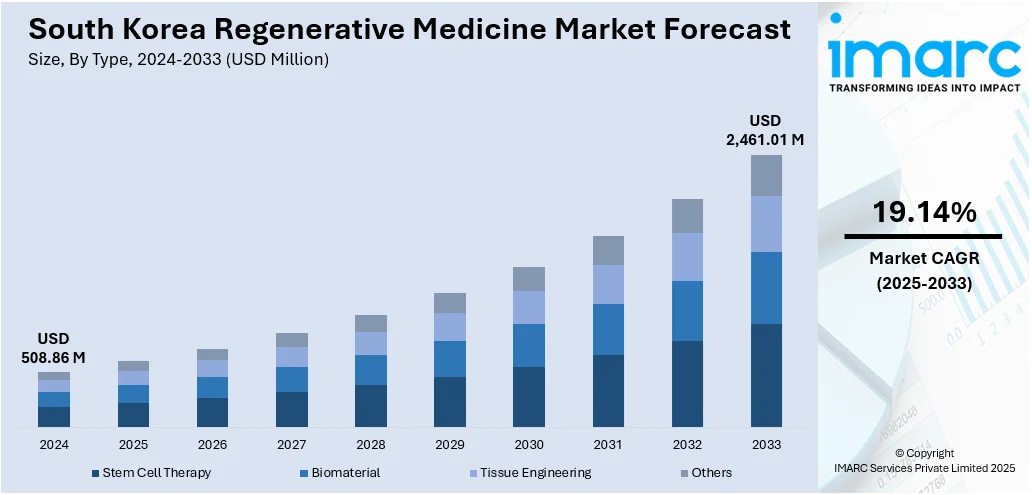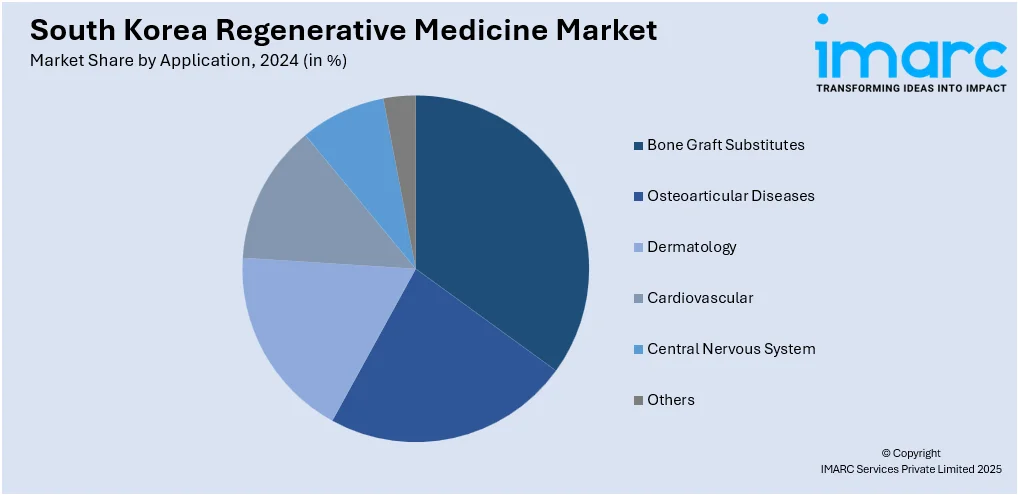
South Korea Regenerative Medicine Market Size, Share, Trends and Forecast by Type, Application, End User, and Region, 2025-2033
South Korea Regenerative Medicine Market Overview:
The South Korea regenerative medicine market size reached USD 508.86 Million in 2024. Looking forward, the market is expected to reach USD 2,461.01 Million by 2033, exhibiting a growth rate (CAGR) of 19.14% during 2025-2033. The market is fostered by high government support, sophisticated healthcare infrastructure, and a lively biotech industry. South Korea's focus on medical tourism and incorporation of regenerative methods in cosmetic and orthopedic procedures fuels local demand. Synergy among universities, research institutes, and biotech companies further fuels clinical breakthroughs. The nation's investment in R&D and its cultural receptiveness to new medical technology also help expand markets and fuel growth of South Korea regenerative medicine market share.
|
Report Attribute
|
Key Statistics
|
|---|---|
|
Base Year
|
2024
|
|
Forecast Years
|
2025-2033
|
|
Historical Years
|
2019-2024
|
| Market Size in 2024 | USD 508.86 Million |
| Market Forecast in 2033 | USD 2,461.01 Million |
| Market Growth Rate 2025-2033 | 19.14% |
South Korea Regenerative Medicine Market Trends:
Government Support and Regulatory Advancements
One of the strongest trends in South Korea's regenerative medicine market is the robust governmental support for driving innovation in the biotechnology and medical industries. The nation has implemented special regulations to facilitate clinical approvals and accelerate commercialization of cell and gene therapies. This forward-looking approach has made South Korea one of the front-runner Asian countries in developing regenerative medicine. The government has also assigned certain industrial parks and bio-clusters like Osong and Daegu for fostering collaboration among research institutes, biotech companies, and hospitals. These areas are furnished with high-end infrastructure specifically designed to host regenerative medicine research, such as stem cell banks and GMP-certified production facilities. This infrastructural and regulatory support helps firms compress product development timelines and reach the market sooner. South Korea's blend of public policy and private sector research provides a fertile ground for frontier therapies and makes the nation a regional hub for innovation.

To get more information on this market, Request Sample
Integration of Regenerative Therapies in Cosmetic and Dermatology Industries
One of the unique trends in South Korea is the extensive integration of regenerative medicine within its long-standing cosmetic and dermatology sectors. Renowned across the world for its dominance in skincare and aesthetic medicine, South Korea is harnessing stem cell and tissue engineering technologies to advance anti-aging treatments, wound healing, and skin regeneration. Such meeting of biotechnology and cosmetic science is fueled mostly by both local demand and the nation's booming medical tourism industry. Most Korean clinics and cosmetic centers today provide innovative treatments such as autologous cell therapy, platelet-rich plasma (PRP), and fibroblast injection, backed by research and product innovation. This is a trend exclusive to South Korea, where cultural focus on appearance and innovation in skincare has led to a niche market for regenerative solutions. The close cooperation between cosmetic firms and biotech companies is now pushing the applications of regenerative medicine beyond the conventional healthcare sector, adding to South Korea's international reputation for merging beauty and science, and also contributing to the South Korea regenerative medicine market growth.
Sudden Advances in Stem Cell and Gene Therapy Research
There is fast-paced advancement in the technology development of stem cell and gene therapy in South Korea, being a significant trend in its regenerative medicine. Academic institutions, biotech firms, and large pharmaceuticals are placing greater emphasis on innovative therapeutic strategies for diseases such as neurodegenerative illnesses, spinal cord injuries, and orphan genetic diseases. The nation's strong research community is bolstered by sophisticated clinical trial infrastructure, large investment in biotech R&D, and highly educated scientific talent. South Korea also boasts one of Asia's most vibrant pipelines for cell-based therapies, indicative of a competitive and innovative environment. Its distinction is the incorporation of regenerative medicine research into multidisciplinary medical centers, facilitating rapid translation from bench to bedside. With increasing global demand for personalized medicine, South Korean companies are also venturing into precision-targeted regenerative treatments, providing the basis for future collaboration and possible leadership in the emerging generation of therapies.
South Korea Regenerative Medicine Market Segmentation:
IMARC Group provides an analysis of the key trends in each segment of the market, along with forecasts at the country and regional levels for 2025-2033. Our report has categorized the market based on type, application, and end user.
Type Insights:
- Stem Cell Therapy
- Biomaterial
- Tissue Engineering
- Others
The report has provided a detailed breakup and analysis of the market based on the type. This includes stem cell therapy, biomaterial, tissue engineering, and others.
Application Insights:

- Bone Graft Substitutes
- Osteoarticular Diseases
- Dermatology
- Cardiovascular
- Central Nervous System
- Others
The report has provided a detailed breakup and analysis of the market based on the application. This includes bone graft substitutes, osteoarticular diseases, dermatology, cardiovascular, central nervous system, and others.
End User Insights:
- Hospitals
- Specialty Clinics
- Others
A detailed breakup and analysis of the market based on the end user has also been provided in the report. This includes hospitals, specialty clinics, and others.
Regional Insights:
- Seoul Capital Area
- Yeongnam (Southeastern Region)
- Honam (Southwestern Region)
- Hoseo (Central Region)
- Others
The report has also provided a comprehensive analysis of all the major regional markets, which include Seoul Capital Area, Yeongnam (Southeastern Region), Honam (Southwestern Region), Hoseo (Central Region), and others.
Competitive Landscape:
The market research report has also provided a comprehensive analysis of the competitive landscape. Competitive analysis such as market structure, key player positioning, top winning strategies, competitive dashboard, and company evaluation quadrant has been covered in the report. Also, detailed profiles of all major companies have been provided.
South Korea Regenerative Medicine Market News:
- On February 21, 2025, South Korea enacted the Regenerative Medicine Law, allowing patients with severe, rare, or untreatable conditions to access cell and gene therapies that are still not completely approved for sale. The Act on the Safety of and Support for Enhanced Regenerative Medicine and Advanced Biological Products is the full name of the statute. It establishes a rigorous regulatory framework aimed at ensuring patient safety while providing additional healthcare choices.
South Korea Regenerative Medicine Market Report Coverage:
| Report Features | Details |
|---|---|
| Base Year of the Analysis | 2024 |
| Historical Period | 2019-2024 |
| Forecast Period | 2025-2033 |
| Units | Million USD |
| Scope of the Report |
Exploration of Historical Trends and Market Outlook, Industry Catalysts and Challenges, Segment-Wise Historical and Future Market Assessment:
|
| Types Covered | Stem Cell Therapy, Biomaterial, Tissue Engineering, Others |
| Applications Covered | Bone Graft Substitutes, Osteoarticular Diseases, Dermatology, Cardiovascular, Central Nervous System, Others |
| End Users Covered | Hospitals, Specialty Clinics, Others |
| Regions Covered | Seoul Capital Area, Yeongnam (Southeastern Region), Honam (Southwestern Region), Hoseo (Central Region), Others |
| Customization Scope | 10% Free Customization |
| Post-Sale Analyst Support | 10-12 Weeks |
| Delivery Format | PDF and Excel through Email (We can also provide the editable version of the report in PPT/Word format on special request) |
Key Questions Answered in This Report:
- How has the South Korea regenerative medicine market performed so far and how will it perform in the coming years?
- What is the breakup of the South Korea regenerative medicine market on the basis of type?
- What is the breakup of the South Korea regenerative medicine market on the basis of application?
- What is the breakup of the South Korea regenerative medicine market on the basis of end user?
- What is the breakup of the South Korea regenerative medicine market on the basis of region?
- What are the various stages in the value chain of the South Korea regenerative medicine market?
- What are the key driving factors and challenges in the South Korea regenerative medicine market?
- What is the structure of the South Korea regenerative medicine market and who are the key players?
- What is the degree of competition in the South Korea regenerative medicine market?
Key Benefits for Stakeholders:
- IMARC’s industry report offers a comprehensive quantitative analysis of various market segments, historical and current market trends, market forecasts, and dynamics of the South Korea regenerative medicine market from 2019-2033.
- The research report provides the latest information on the market drivers, challenges, and opportunities in the South Korea regenerative medicine market.
- Porter's five forces analysis assist stakeholders in assessing the impact of new entrants, competitive rivalry, supplier power, buyer power, and the threat of substitution. It helps stakeholders to analyze the level of competition within the South Korea regenerative medicine industry and its attractiveness.
- Competitive landscape allows stakeholders to understand their competitive environment and provides an insight into the current positions of key players in the market.
Need more help?
- Speak to our experienced analysts for insights on the current market scenarios.
- Include additional segments and countries to customize the report as per your requirement.
- Gain an unparalleled competitive advantage in your domain by understanding how to utilize the report and positively impacting your operations and revenue.
- For further assistance, please connect with our analysts.
 Request Customization
Request Customization
 Speak to an Analyst
Speak to an Analyst
 Request Brochure
Request Brochure
 Inquire Before Buying
Inquire Before Buying




.webp)




.webp)












